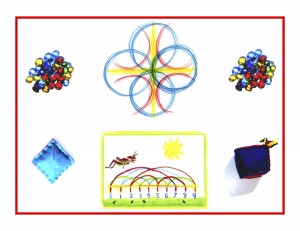Day 114
For one year, 365 days, this blog will address the Common Core Standards from the perspective of creating an alternate, ambient learning environment for math. Ambient is defined as “existing or present on all sides, an all-encompassing atmosphere.” And ambient music is defined as: “Quiet and relaxing with melodies that repeat many times.”
Why ambient? A math teaching style that’s whole and all encompassing, with themes that repeat many times through the years, is most likely to be effective and successful. Today’s post will review the Geometry standards posted earlier in relation to the form drawing block. The standards will be listed in blue, followed by a summary of the post.
Geometry 1.G
Reason with shapes and their attributes.
1. Distinguish between shapes and their attributes (e.g., triangles are closed and three-sided) versus non-defining attributes (e.g., color, orientation, overall size); build and draw shapes to possess defining attributes.
Day 52: a brief description of the form drawing process, the straight line and curve as the basis of all forms, and the relationship of many geometric forms to the numbers 1-12.
Geometry 1.G
Reason with shapes and their attributes.
2. Compose two-dimensional shapes (rectangles, squares, trapezoids, triangles, half-circles, and quarter-circles) or three dimensional shapes (cubes, right rectangular prisms, right circular cones, and right circular cylinders) to create a composite shape, and compose new shapes from the composite shape.
Day 53: all of these two-dimensional shapes are covered with form drawing, with the circle divided into halves, quarters, eighths, tenths, twelfths, etc. Choosing shapes on worksheets does not do geometry justice, and geometry terms should not be formalized yet. See the Kindergarten post on Day 18, for a hands-on approach to the three dimensional forms. See-through plastic geometry models work well for exploring these shapes. It’s noted that the California State and National Math Standards were more user and child-friendly. Common Core favors a “parts-to-whole” approach that’s abstract and developmentally inappropriate.
Day 54: listing of the California State and National Math Standards and their relationship to / alignment with the Math By Hand form drawing lessons. Question: is the inordinate amount of professional development, lesson prep time, and teaching to the test precluding teachers’ ability to teach meaningfully and effectively?
Geometry 1.G
Reason with shapes and their attributes.
3. Partition circles and rectangles into two and four equal shares, describe the shares using the words halves, fourths, and quarters, and use the phrases half of, fourth of, and quarter of, describe the whole as two of, or four of the shares. Understand for these examples that decomposing into more equal shares creates smaller shares.
Day 55 (in its entirety): The Waldorf method waits until Grade 4 to introduce fractions because the stages of child development determine the time frame of the curriculum. There are solid physiological reasons to wait until age 7 to begin formal teaching, and there are parallel reasons at every stage and age to introduce concepts at the optimal time. Every one of the child’s growth stages marks a significant step away from childhood. The Waldorf method recognizes and heeds these milestones as the drivers of what’s introduced when. For example, creation stories and housebuilding are told and taught in Grade 3 because at age 9, the leave-taking from the garden of childhood is especially intense. Creation stories address this leaving the garden as another step into the world, while supporting accompanying feelings of loss with the tools of living on the earth: gardening, housebuilding, and other useful crafts.
Fractions wait until Grade 4 because they echo the feelings of separation that manifest at that age. Everything in Grade 1 is steeped in the holistic. The circle is broken up into parts, but from a very different angle. The numbers are introduced with a piece of fruit cut up to show how 1 becomes 2, 2 becomes 4, and 4 becomes 8. A form drawing of the circle divided into 8 parts reflects this concept. Wholeness is key now, and though many circles, squares, rectangles, triangles, hexagons, octagons, and more will be partitioned into two and four (and more) equal shares with form drawing, they are not yet equated with fraction terminology.
Faith and trust in the child, the teacher or parent, and the things of the world that can reveal themselves in due course and at the right time is the golden rule. True knowledge ensues in an environment dedicated to imaginative, creative knowing, where student and teacher alike surrender to the ensuing of that knowledge as a worthy goal. All that the Common Core asks (and so much more) is covered by the excellence that is form drawing.












